Homogeneous Iron Catalysts For The Conversion Of Methanol To Methyl Formate And Hydrogen
Chakraborty; Sumit ; et al.
U.S. patent application number 16/043303 was filed with the patent office on 2019-02-07 for homogeneous iron catalysts for the conversion of methanol to methyl formate and hydrogen. This patent application is currently assigned to Eastman Chemical Company. The applicant listed for this patent is Eastman Chemical Company. Invention is credited to Steven J. Adams, Scott Donald Barnicki, Sumit Chakraborty, Robert Thomas Hembre.
| Application Number | 20190039990 16/043303 |
| Document ID | / |
| Family ID | 65229216 |
| Filed Date | 2019-02-07 |
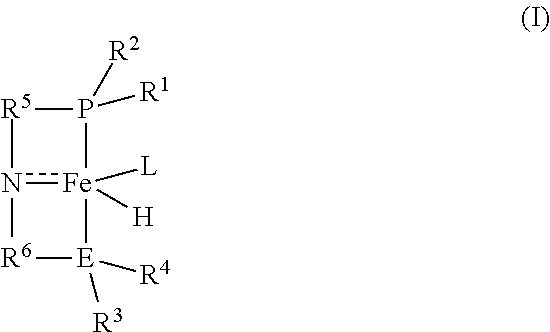
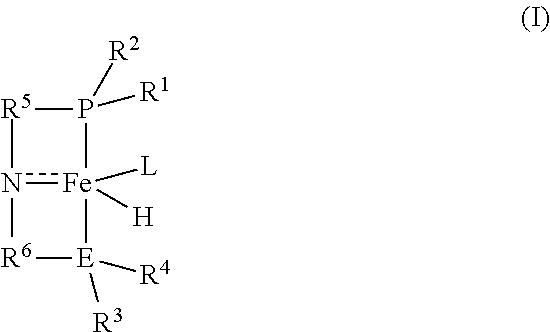
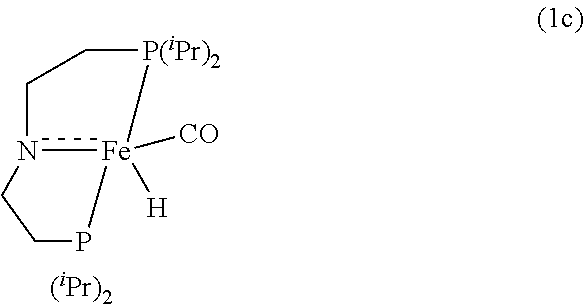
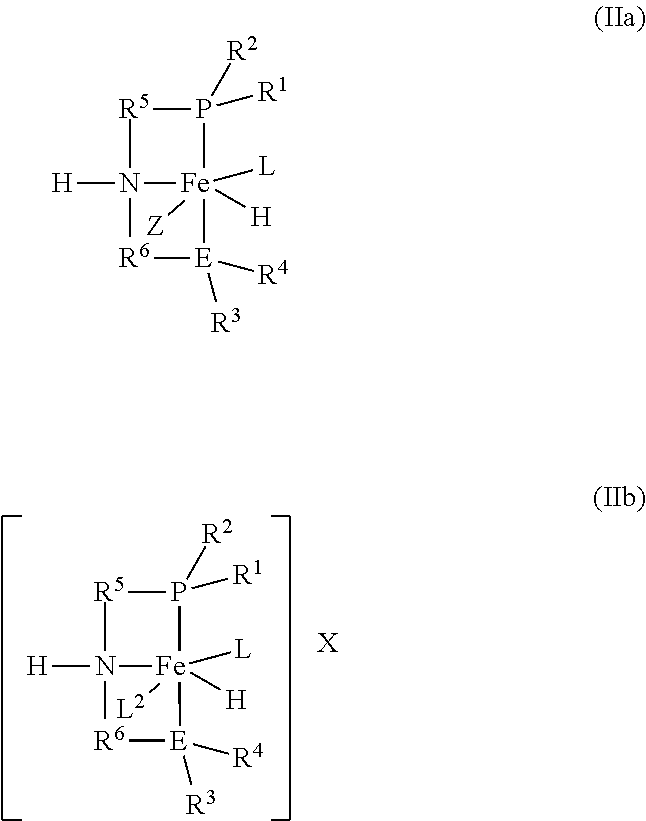
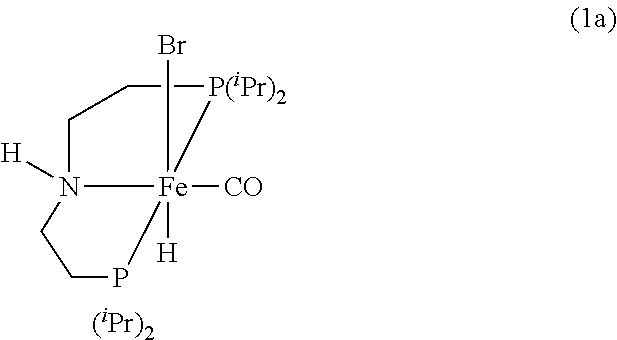
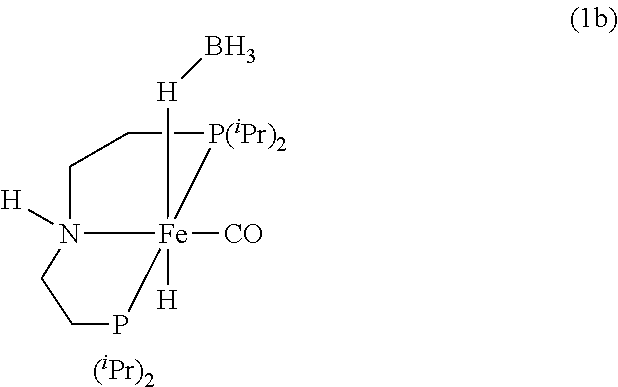
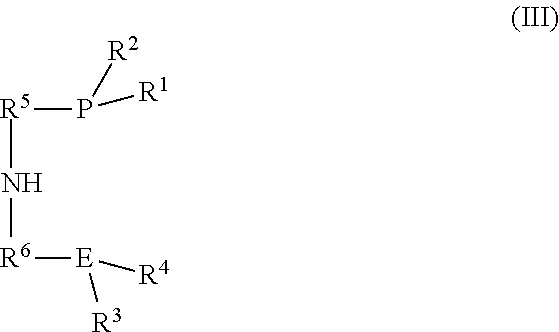
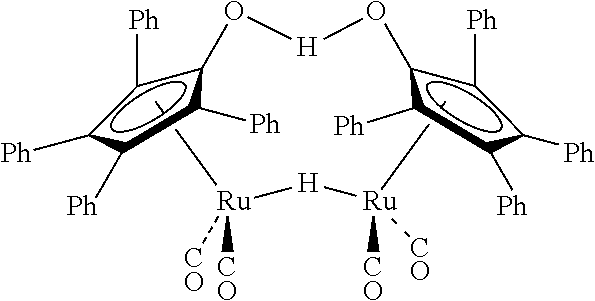
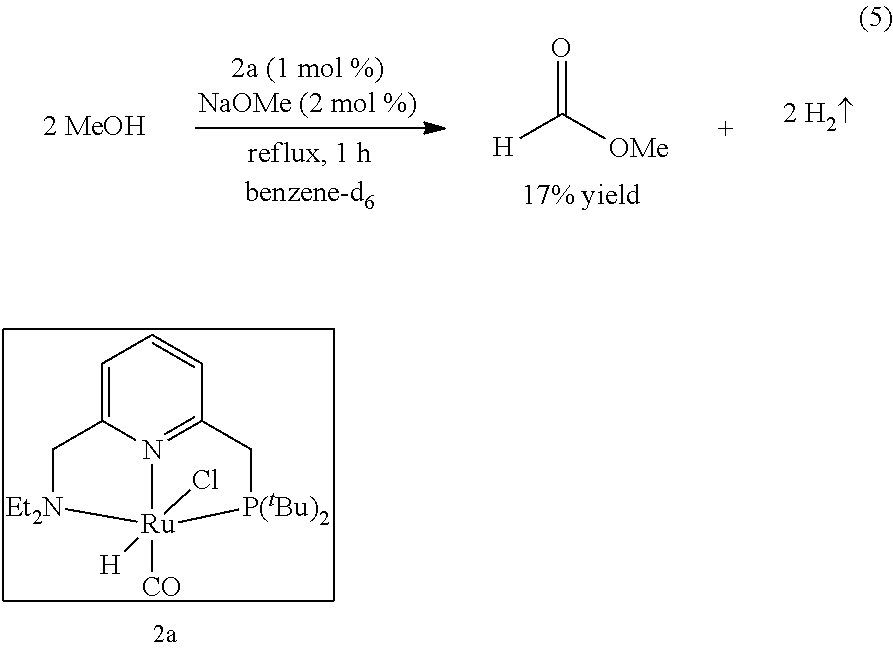
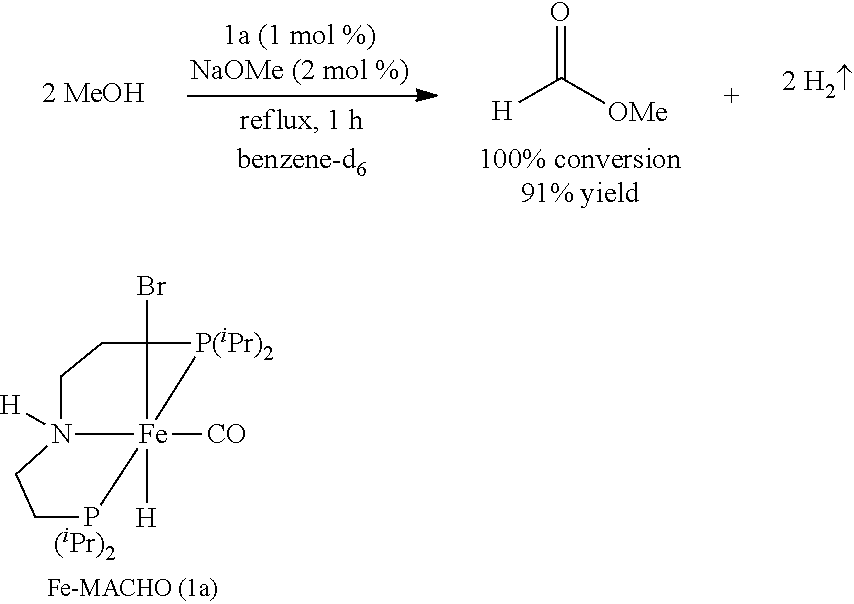
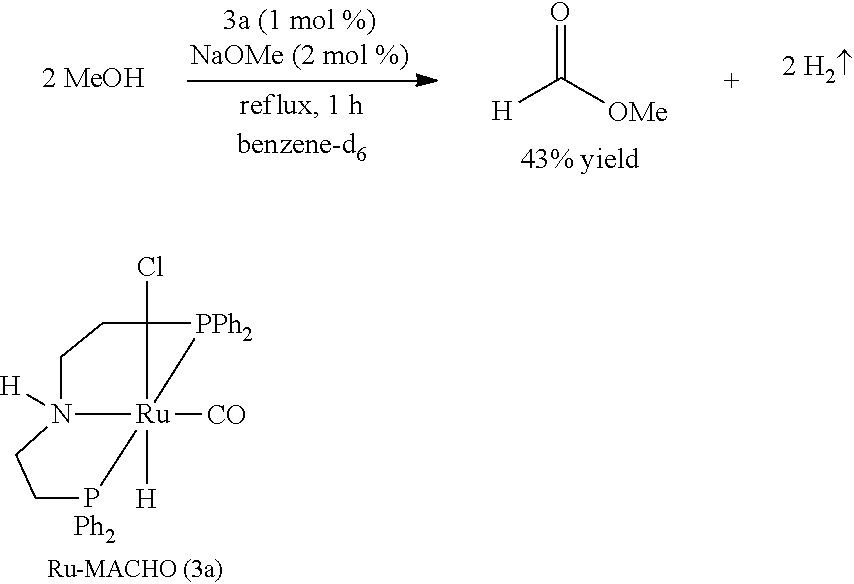
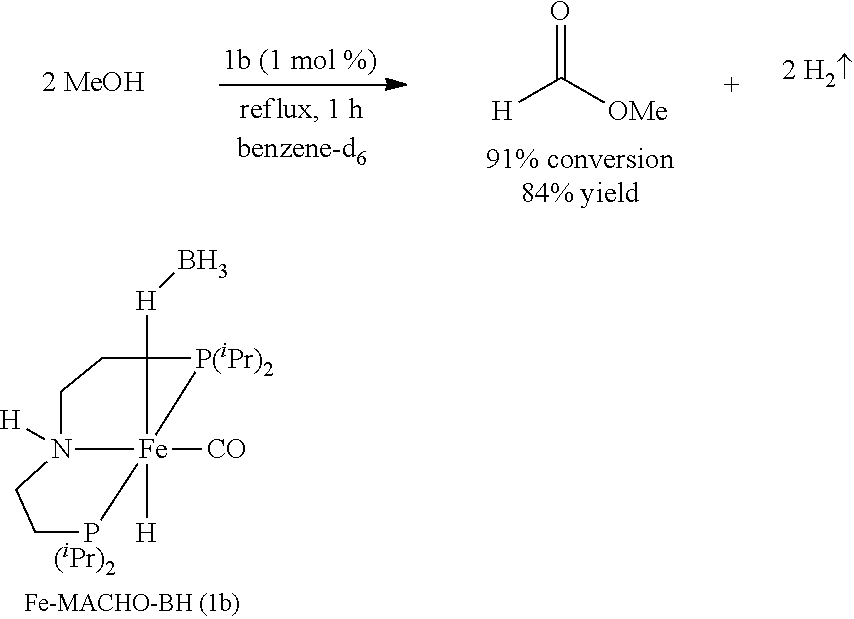
View All Diagrams
| United States Patent Application | 20190039990 |
| Kind Code | A1 |
| Chakraborty; Sumit ; et al. | February 7, 2019 |
HOMOGENEOUS IRON CATALYSTS FOR THE CONVERSION OF METHANOL TO METHYL FORMATE AND HYDROGEN
Abstract
Iron-based homogeneous catalysts, supported by pincer ligands, are employed in the catalytic dehydrocoupling of methanol to produce methyl formate and hydrogen. As both methanol and methyl formate are volatile materials, they can be readily separated from the catalyst by applying vacuum at room temperature. The hydrogen by-product of the reaction may be isolated and utilized as a feedstock in other chemical transformations.
| Inventors: | Chakraborty; Sumit; (Johnson City, TN) ; Adams; Steven J.; (Gray, TN) ; Hembre; Robert Thomas; (Johnson City, TN) ; Barnicki; Scott Donald; (Kingsport, TN) | ||||||||||
| Applicant: |
|
||||||||||
|---|---|---|---|---|---|---|---|---|---|---|---|
| Assignee: | Eastman Chemical Company Kingsport TN |
||||||||||
| Family ID: | 65229216 | ||||||||||
| Appl. No.: | 16/043303 | ||||||||||
| Filed: | July 24, 2018 |
Related U.S. Patent Documents
| Application Number | Filing Date | Patent Number | ||
|---|---|---|---|---|
| 62540304 | Aug 2, 2017 | |||
| Current U.S. Class: | 1/1 |
| Current CPC Class: | C01B 2203/1223 20130101; C07F 15/02 20130101; C01B 3/02 20130101; B01J 31/24 20130101; C01B 3/22 20130101; B01J 2531/842 20130101; B01J 31/20 20130101; C01B 2203/0277 20130101; B01J 2231/49 20130101; B01J 2231/763 20130101; B01J 2531/0244 20130101; C07C 67/00 20130101; B01J 2531/0258 20130101; C01B 2203/04 20130101; C01B 2203/048 20130101; B01J 31/189 20130101; C07C 67/00 20130101; C07C 69/06 20130101 |
| International Class: | C07C 67/00 20060101 C07C067/00; C01B 3/02 20060101 C01B003/02; C07F 15/02 20060101 C07F015/02; B01J 31/24 20060101 B01J031/24 |
Claims
1. A process for preparing methyl formate and hydrogen, the process comprising contacting anhydrous methanol with a catalyst of the formula (I): ##STR00015## in a reactor at conditions effective to form methyl formate and hydrogen, wherein R.sup.1 and R.sup.2 are each independently an alkyl, aryl, alkoxy, aryloxy, dialkylamido, diarylamido, or alkylarylamido group having 1 to 12 carbon atoms; R.sup.3 and R.sup.4 are each independently an alkyl or aryl group having 1 to 12 carbon atoms, if E is nitrogen; R.sup.3 and R.sup.4 are each independently an alkyl, aryl, alkoxy, aryloxy, dialkylamido, diarylamido, or alkylarylamido group having 1 to 12 carbon atoms, if E is phosphorus; R.sup.1, R.sup.2, and P may be connected to form a 5 or 6-membered heterocyclic ring; R.sup.3, R.sup.4, and E may be connected to form a 5 or 6-membered heterocyclic ring; R.sup.5 and R.sup.6 are each independently a C.sub.1-C.sub.6 alkylene or arylene group; E is phosphorus or nitrogen; and L is a neutral ligand.
2. The process according to claim 1, wherein the catalyst is formed by introducing a pre-catalyst of the formulas (IIa) or (IIb): ##STR00016## into the reactor and exposing the pre-catalyst to heat, an acid, a base, or combinations thereof; and wherein R.sup.1, R.sup.2, R.sup.3, R.sup.4, R.sup.5, R.sup.6, E, and L are as defined in formula (I); Z is R.sup.7 or X; R.sup.7 is hydrogen or an alkyl or aryl group; X is [BH.sub.4].sup.- or a halide; and L.sup.2 is a neutral ligand.
3. The process according to claim 1, wherein the catalyst is formed by: (a) introducing (i) an iron salt or an iron complex comprising the neutral ligand (L), (ii) a ligand of the formula (III): ##STR00017## and (iii) optionally the neutral ligand (L) into the reactor to form a pre-catalyst mixture; and (b) optionally exposing the pre-catalyst mixture to heat, an acid, a base, or combinations thereof; wherein R.sup.1, R.sup.2, R.sup.3, R.sup.4, R.sup.5, R.sup.6, and E are as defined in formula (I).
4. The process according to claim 1, wherein one or more of R.sup.1, R.sup.2, R.sup.3, and R.sup.4 are substituted with one or more groups selected from ethers, esters, and amides.
5. The process to claim 1, wherein R.sup.1, R.sup.2, R.sup.3, and R.sup.4 are each independently a methyl, ethyl, propyl, isopropyl, butyl, pentyl, isopentyl, cyclopentyl, hexyl, cyclohexyl, or phenyl group.
6. The process according to claim 5, wherein each of R.sup.1, R.sup.2, R.sup.3, and R.sup.4 is isopropyl.
7. The process according to claim 5, wherein each of R.sup.1, R.sup.2, R.sup.3, and R.sup.4 is phenyl.
8. The process according to claim 1, wherein each of R.sup.5 and R.sup.6 is --(CH.sub.2CH.sub.2)--.
9. The process according to claim 1, wherein E is phosphorus.
10. The process according to claim 1, wherein L is carbon monoxide, a phosphine, an amine, a nitrile, or an N-containing heterocyclic ligand.
11. The process according to claim 2, wherein L.sup.2 is an ether, an ester, an amide, a nitrile, or an N-containing heterocyclic ligand.
12. The process according to claim 1, wherein the contacting step is conducted at a temperature of 40 to 160.degree. C.
13. The process according to claim 1, wherein the contacting step is conducted in the presence of a solvent.
14. The process according to claim 1, wherein the contacting step is conducted in the absence of a solvent.
15. The process according to claim 1, wherein the contacting step is conducted in the absence of a base.
16. The process according to claim 2, wherein the base is a metal alkoxide or a nitrogen-containing compound.
17. The process according to claim 16, wherein the base is sodium methoxide, sodium ethoxide, or triethylamine.
Description
CROSS REFERENCE TO RELATED APPLICATION
[0001] This application claims the benefit of Provisional Application 62/540,304 filed on Aug. 2, 2017 under 35 U.S.C. .sctn. 119(e)(1), the entire content of which is incorporated herein by reference.
FIELD OF THE INVENTION
[0002] The invention generally relates to the field of organic chemistry. It particularly relates to the catalytic dehydrocoupling of methanol to produce methyl formate.
BACKGROUND OF THE INVENTION
[0003] Methyl formate is a key intermediate in the production of formic acid. It is also a useful building block molecule in C.sub.1 chemistry. Currently, methyl formate is industrially produced by carbonylation of methanol using sodium methoxide as the catalyst and dry CO as the carbonylating reagent. However, producing methyl formate through the carbonylation route has several major drawbacks. For example, the percent yield of methyl formate is relatively low, and the reaction is generally carried out under relatively high CO pressures. Moreover, this process relies on the use of hazardous and flammable CO gas, which is difficult to transport in bulk. Accordingly, there is a need for more efficient and greener processes for synthesizing methyl formate from methanol, particularly without using the toxic CO gas.
[0004] The present invention addresses this need as well as others, which will become apparent from the following description and the appended claims.
SUMMARY OF THE INVENTION
[0005] The invention is as set forth in the appended claims.
[0006] Briefly, the invention provides a process for preparing methyl formate and hydrogen. The process comprises contacting anhydrous methanol with a catalyst of the formula (I):
##STR00001##
in a reactor at conditions effective to form methyl formate and hydrogen, wherein
[0007] R.sup.1 and R.sup.2 are each independently an alkyl, aryl, alkoxy, aryloxy, dialkylamido, diarylamido, or alkylarylamido group having 1 to 12 carbon atoms;
[0008] R.sup.3 and R.sup.4 are each independently an alkyl or aryl group having 1 to 12 carbon atoms, if E is nitrogen;
[0009] R.sup.3 and R.sup.4 are each independently an alkyl, aryl, alkoxy, aryloxy, dialkylamido, diarylamido, or alkylarylamido group having 1 to 12 carbon atoms, if E is phosphorus;
[0010] R.sup.1, R.sup.2, and P may be connected to form a 5 or 6-membered heterocyclic ring;
[0011] R.sup.3, R.sup.4, and E may be connected to form a 5 or 6-membered heterocyclic ring;
[0012] R.sup.5 and R.sup.6 are each independently a C.sub.1-C.sub.6 alkylene or arylene group;
[0013] E is phosphorus or nitrogen; and
[0014] L is a neutral ligand.
DETAILED DESCRIPTION OF THE INVENTION
[0015] It has been surprisingly discovered that methyl formate can be directly produced, in high yields, by performing a dehydrogenative coupling (DHC or dehydrocoupling) reaction of methanol in the presence of a homogeneous iron catalyst containing a tridentate pincer ligand. This reaction does not require the use of toxic, pressurized CO gas and has the added value of co-producing dihydrogen as the only by-product. Methyl formate is exclusively produced in this reaction. No other by-products, such as formaldehyde or dimethoxymethane, can be detected in the crude reaction mixture by 1H NMR spectroscopy. Quite unexpectedly, the iron catalyst shows superior reactivity compared to corresponding ruthenium-based catalysts under identical conditions.
[0016] Thus, in one aspect, the present invention provides a process for preparing methyl formate and hydrogen. The process comprises the step of contacting anhydrous methanol with a catalyst of the formula (I):
##STR00002##
in a reactor at conditions effective to form methyl formate and hydrogen.
[0017] R.sup.1 and R2 in the formula (I) are each independently an alkyl, aryl, alkoxy, aryloxy, dialkylamido, diarylamido, or alkylarylamido group having 1 to 12 carbon atoms.
[0018] R3 and R4 in the formula (I) are each independently an alkyl or aryl group having 1 to 12 carbon atoms, if E is nitrogen.
[0019] R3 and R4 in the formula (I) are each independently an alkyl, aryl, alkoxy, aryloxy, dialkylamido, diarylamido, or alkylarylamido group having 1 to 12 carbon atoms, if E is phosphorus.
[0020] R5 and R6 in the formula (I) are each independently a C1-C6 alkylene or arylene group.
[0021] E in the formula (I) is phosphorus or nitrogen.
[0022] L in the formula (I) is a neutral ligand.
[0023] R1, R2, and P in the formula (I) may be connected to form a 5 or 6-membered heterocyclic ring.
[0024] R3, R4, and E in the formula (I) may be connected to form a 5 or 6-membered heterocyclic ring.
[0025] One or more of R1, R2, R3, and R4 may be substituted with one or more groups selected from ethers, esters, and amides. The substituents on R1, R2, R3, and R4, if any, may be the same or different.
[0026] Examples of ether groups include methoxy, ethoxy, isopropoxy, and the like.
[0027] Examples of ester groups include formate, acetate, propionate, and the like.
[0028] Examples of amide groups include dimethylamido, diethylamido, diisopropylamido, and the like.
[0029] As used herein, the term "alkyl" refers to straight, branched, or cyclic alkyl groups. Examples of such groups include methyl, ethyl, n-propyl, isopropyl, n-butyl, sec-butyl, isobutyl, tert-butyl, n-pentyl, tert-pentyl, neopentyl, isopentyl, sec-pentyl, 3-pentyl, cyclopentyl, n-hexyl, isohexyl, cyclohexyl, and the like.
[0030] The term "aryl" refers to phenyl or naphthyl.
[0031] The term "alkylene" refers to a divalent alkyl group.
[0032] The term "arylene" refers to a divalent aryl group.
[0033] The term "alkoxy" refers to an --OR group, such as --OCH3, --OEt, --OiPr, --OBu, --OiBu, and the like.
[0034] The term "aryloxy" refers to an --OAr group, such as --OPh, --O (substituted Ph), --Onaphthyl, and the like.
[0035] The term "dialkylamido" refers to an --NR'R'' group, such as dimethylamido, diethylamido, diisopropylamido, and the like.
[0036] The term "diarylamido" refers to an --NAr'Ar'' group, such as diphenylamido.
[0037] The term "alkylarylamido" refers to an --NRAr group, such as methylphenylamido.
[0038] The term "neutral ligand" refers to a ligand with a neutral charge. Examples of neutral ligands include carbon monoxide, an ether compound, an ester compound, a phosphine compound, an amine compound, an amide compound, a nitrile compound, and an N-containing heterocyclic compound. Examples of neutral phosphine ligands include trimethylphosphine, tricyclohexylphosphine, triphenylphosphine, and the like. Examples of neutral amine ligands include trialkylamines, alkylarylamines, and dialkylarylamines, such as trimethylamine and N,N-dimethylanaline. Examples of neutral nitrile ligands include acetonitrile. Examples of neutral N-containing heterocyclic ligands include pyridine and 1,3-dialkyl- or diaryl-imidazole carbenes.
[0039] In one embodiment, R1, R2, R3, and R4 are all isopropyl. In another embodiment, R1, R2, R3, and R4 are all phenyl.
[0040] In one embodiment, R5 and R6 are both --(CH2CH2)-.
[0041] In one embodiment, E is phosphorus.
[0042] In various embodiments, the catalyst of the formula (I) has the formula (1c):
##STR00003##
where .sup.iPr represents an isopropyl group.
[0043] Anhydrous methanol is commercially available in various grades, such as >99 wt % of methanol, 99-100 wt % of methanol, 99.7 wt % of methanol, 99.8 wt % of methanol, and 100 wt % of methanol. Any of these grades may be used in the DHC reaction.
[0044] Preferably, the reaction mixture contains less than 1 wt %, less than 0.5 wt %, less than 0.4 wt %, less than 0.3 wt %, less than 0.2 wt %, less than 0.1 wt %, less than 0.05 wt %, less than 0.01 wt %, less than 0.005 wt %, or less than 0.001 wt % of water, based on the total weight of the reaction mixture. In one embodiment, the DHC reaction is carried out in the absence of water.
[0045] The catalyst of the formula (I) may be prepared in multiple ways. For example, the catalyst may be formed in situ by introducing a pre-catalyst of the formulas (IIa) or (IIb):
##STR00004##
into the reactor and exposing the pre-catalyst to heat, an acid, a base, or combinations thereof to form the catalyst of the formula (I).
[0046] R.sup.1, R.sup.2, R3, R4, R5, R6, E, and L in the formulas (IIa) or (IIb) are as defined in formula (I).
[0047] Z in the formula (IIa) is R7 or X.
[0048] R7 is hydrogen or an alkyl or aryl group.
[0049] X is [BH4]- or a halide.
[0050] L2 in the formula (IIb) is a neutral ligand.
[0051] The alkyl or aryl group represented by R7 may contain from 1 to 12 carbon atoms.
[0052] The halides represented by X include chloride, bromide, and iodide. In one embodiment, X is chloride or bromide.
[0053] Examples of the neutral ligand L2 include an ether compound, an ester compound, an amide compound, a nitrile compound, and an N-- containing heterocyclic compound.
[0054] In one embodiment, when X is a halide, the pre-catalyst is exposed to a base and optionally to heat to generate the catalyst.
[0055] In another embodiment, when X is [BH4]-, the pre-catalyst is exposed to heat, but optionally in the absence of a base, to generate the catalyst.
[0056] As used herein, the expression "in the absence of" means the component referred to is not added from an external source or, if added, is not added in an amount that affects the DHC reaction to an appreciable extent, for example, an amount that can change the yield of methyl formate by more than 10%, by more than 5%, by more than 1%, by more than 0.5%, or by more than 0.1%.
[0057] In various embodiments, the pre-catalyst of the formula (IIa) has the formula (1a):
##STR00005##
where .sup.iPr represents an isopropyl group.
[0058] In various embodiments, the pre-catalyst of the formula (IIb) has the formula (1b):
##STR00006##
where .sup.iPr represents an isopropyl group.
[0059] Alternatively, the catalyst of the formula (I) may be formed in situ by the steps of:
[0060] (a) introducing (i) an iron salt or an iron complex comprising the neutral ligand (L), (ii) a ligand of the formula (III):
##STR00007##
and (iii) optionally the neutral ligand (L) into the reactor to form a pre-catalyst mixture; and
[0061] (b) optionally exposing the pre-catalyst mixture to heat, an acid, a base, or combinations thereof to form the catalyst of the formula (I).
[0062] R.sup.1, R2, R3, R4, R5, R6, and E in the formula (III) are as defined in formula (I).
[0063] Examples of iron salts suitable for making the catalyst of the formula (I) include [Fe(H2O)6](BF4)2, Fe(CO)5, FeCl2, FeBr2, FeI2, [Fe3(CO)12], Fe(NO3)2, FeSO4, and the like.
[0064] Iron complexes comprising the neutral ligand (L) may be made by methods known in the art and/or are commercially available.
[0065] Ligands of the formula (III) may be made by methods known in the art and/or are commercially available.
[0066] The heat employed for generating the catalyst is not particularly limiting. It may be the same as the heat used for the DHC reaction. For example, the pre-catalyst or pre-catalyst mixture may be exposed to elevated temperatures, such as from 40 to 200.degree. C., 40 to 160.degree. C., 40 to 150.degree. C., 40 to 140.degree. C., 40 to 130.degree. C., 40 to 120.degree. C., 40 to 100.degree. C., 80 to 160.degree. C., 80 to 150.degree. C., 80 to 140.degree. C., 80 to 130.degree. C., 80 to 120.degree. C., or 80 to 100.degree. C., to form the catalyst.
[0067] The acid for forming the catalyst is not particularly limiting. Examples of suitable acids include formic acid, HBF4, HPF6, HOSO2CF3, and the like.
[0068] The base for forming the catalyst is not particularly limiting. Both inorganic as well as organic bases may be used. Examples of suitable inorganic bases include Na, K, NaH, NaOH, KOH, CsOH, LiHCO3, NaHCO.sub.3, KHCO3, CsHCO3, Li.sub.2CO.sub.3, Na.sub.2CO.sub.3, K.sub.2CO.sub.3, Cs.sub.2CO.sub.3, and the like. Suitable organic bases include metal alkoxides and nitrogen-containing compounds. Examples of suitable metal alkoxides include alkali-metal C.sub.1-C.sub.6 alkoxides, such as LiOEt, NaOEt, KOEt, and KOt-Bu. In one embodiment, the base is sodium methoxide (NaOMe). In another embodiment, the base is sodium ethoxide (NaOEt). Examples of nitrogen-containing bases include trialkylamines, such as triethylamine.
[0069] Typically, a 1:1 molar equivalent of base to catalyst precursor is used to generate the catalyst. More than a 1:1 molar equivalent ratio may be used, e.g., a 2:1 ratio of base to catalyst precursor. However, using a large excess amount of base should be avoided, as it may suppress the formation of methyl formate.
[0070] The conditions effective for forming methyl formate include an elevated temperature. The temperature conducive for the DHC reaction may range, for example, from 40 to 200.degree. C., 40 to 160.degree. C., 40 to 150.degree. C., 40 to 140.degree. C., 40 to 130.degree. C., 40 to 120.degree. C., 40 to 100.degree. C., 80 to 160.degree. C., 80 to 150.degree. C., 80 to 140.degree. C., 80 to 130.degree. C., 80 to 120.degree. C., or 80 to 100.degree. C.
[0071] The pressure at which the dehydrocoupling reaction may be carried out is not particularly limiting. For example, the pressure may range from atmospheric to 2 MPa. The reaction may be performed in an open reactor where the produced hydrogen may be withdrawn as the reaction proceeds. Alternatively, the reaction may be performed in a sealed reactor where the produced hydrogen remains in the reactor.
[0072] Preferably, the contacting step/dehydrocoupling reaction is carried out in the absence of a base. Basic conditions during the reaction may tend to suppress the formation of methyl formate.
[0073] The dehydrocoupling reaction may be conducted in the presence or absence of a solvent. In one embodiment, the contacting step/DHC reaction is conducted in the presence of a solvent. In another embodiment, the contacting step/DHC reaction is conducted in the absence of a solvent.
[0074] If desired, the DHC reaction may be performed in common non-polar solvents, such as aliphatic or aromatic hydrocarbons, or in slightly polar, aprotic solvents, such as ethers and esters. Examples of aliphatic solvents include pentanes and hexanes. Examples of aromatic solvents include benzene, xylenes, toluene, and trimethylbenzenes. Examples of ethers include tetrahydrofuran, dioxane, diethyl ether, and polyethers. Examples of esters include ethyl acetate.
[0075] In one embodiment, the solvent is toluene. In another embodiment, the solvent is mesitylene.
[0076] If used, the solvent may be added in amounts of 1:1 to 100:1 or 1:1 to 20:1 (v/v), relative to the amount of methanol.
[0077] As noted above, to transform methanol to methyl formate and hydrogen, the reaction mixture is generally heated to elevated temperatures, for example, from 40 to 160.degree. C. In one embodiment, the reaction is conducted in refluxing benzene, xylene(s), mesitylene, or toluene at atmospheric pressure.
[0078] The DHC reaction can take place with catalyst loadings of 25 ppm (0.0025 mol %). For example, the reaction may be carried out with catalyst loadings of 50 to 20,000 ppm (0.005 to 2 mol %), 100 to 15,000 ppm (0.01 to 1.5 mol %), 100 to 10,000 ppm (0.01 to 1 mol %), 100 to 1,000 ppm (0.01 to 0.1 mol %), or 100 to 500 ppm (0.01 to 0.05 mol %).
[0079] In accordance with an embodiment of the invention, the catalyst or catalyst precursor(s) is/are combined with methanol, and optionally a solvent, at a weight ratio of 1:10 to 1:100,000 in a reactor. The mixture is heated with mixing to a temperature of 40 to 160.degree. C. for a period of 1-6 hours during which time hydrogen (H2) is evolved, and may be removed from the reactor or not. It is possible to carry the reaction to full conversion, but it may be advantageous to limit the conversion due to rates and reaction pressures.
[0080] The product, methyl formate, may be removed from the product solution at a modest temperature (methyl formate b.p.=32.degree. C.) along with methanol or other volatile products (e.g., at less than 60.degree. C.) and conveniently condensed with a variety of condenser designs at a temperature around 0.degree. C.
[0081] Hydrogen is readily separated from the reaction liquids, which are condensed at this temperature and may be purified and compressed for alternative uses. These operations may be carried out in a batch or continuous mode. A catalyst containing concentrate may be recycled with addition of fresh methanol.
[0082] The process according to the invention can produce methyl formate with yields of at least 50%, at least 60%, at least 70%, at least 80%, or at least 90%. The reaction times in which these yields may be achieved include 6 hours or less, 5 hours or less, 4 hours or less, 3 hours or less, 2 hours or less, or 1 hour or less.
[0083] The present invention includes and expressly contemplates any and all combinations of embodiments, features, characteristics, parameters, and/or ranges disclosed herein. That is, the invention may be defined by any combination of embodiments, features, characteristics, parameters, and/or ranges mentioned herein.
[0084] As used herein, the indefinite articles "a" and "an" mean one or more, unless the context clearly suggests otherwise. Similarly, the singular form of nouns includes their plural form, and vice versa, unless the context clearly suggests otherwise.
[0085] While attempts have been made to be precise, the numerical values and ranges described herein should be considered to be approximations (even when not qualified by the term "about"). These values and ranges may vary from their stated numbers depending upon the desired properties sought to be obtained by the present invention as well as the variations resulting from the standard deviation found in the measuring techniques. Moreover, the ranges described herein are intended and specifically contemplated to include all sub-ranges and values within the stated ranges. For example, a range of 50 to 100 is intended to describe and include all values within the range including sub-ranges such as 60 to 90 and 70 to 80.
[0086] The content of all documents cited herein, including patents as well as non-patent literature, is hereby incorporated by reference in their entirety. To the extent that any incorporated subject matter contradicts with any disclosure herein, the disclosure herein shall take precedence over the incorporated content.
[0087] This invention can be further illustrated by the following examples of preferred embodiments thereof, although it will be understood that these examples are included merely for purposes of illustration and are not intended to limit the scope of the invention unless otherwise specifically indicated.
EXAMPLES
General Experimental Information
[0088] Unless otherwise noted, all the organometallic compounds were prepared and handled under a nitrogen atmosphere using standard Schlenk and glovebox techniques. Anhydrous methanol (99.7% assay) and mesitylene (98%) were purchased from Sigma Aldrich and used without further purification. Benzene-d.sub.6 was purchased from Cambridge Isotope Laboratory and stored under dry 4 .ANG. molecular sieves. .sup.1H NMR spectra were recorded on Bruker Avance-500 MHz spectrometers. Chemical shift values in .sup.1H NMR spectra were referenced internally to the residual solvent resonances (.delta. 7.16 for benzene-d.sub.6). Compounds 2-4 have been previously reported in the literature. They were synthesized according to the literature procedures (see Kuriyama et al., Org. Process Res. Dev. 2012, 16, 166; Werkmeister et al., Chem. Eur. J. 2015, 21, 12226 and references cited therein; Chakraborty et al., Acc. Chem. Res. 2015, 48, 1995 and references cited therein; Zhang et al., J. Am. Chem. Soc. 2005, 127, 10840; Gunanathan et al., J. Am. Chem. Soc. 2009, 131, 3146; Zhang et al., Organometallics 2011, 30, 5716; and Alberico et al., Angew. Chem. Int. Ed. 2013, 52, 14162). Shvo's catalyst was purchased from Strem Chemicals and used without further purification.
General Procedure for the Preparation of Fe-MACHO Catalysts
[0089] The catalysts were prepared by the process described in Chakaraborty et al., J. Am. Chem. Soc. 2014, 136, 8564.
Modified Synthesis of 1a [(.sup.iPrPNHP)Fe(H)(CO)(Br)]
[0090] In a glovebox, under a nitrogen atmosphere, a 200-mL oven-dried Schlenk flask was charged with complex [.sup.iPrPNHP]FeBr.sub.2(CO) (850 mg, 1.545 mmol), NaBH.sub.4 (60 mg, 1.545 mmol, 98% purity), and 100 mL of dry EtOH. The resulting yellow solution was stirred for 18 hours at room temperature, filtered through Celite, and the filtrate was evaporated to dryness to obtain pure 1a (83% isolated yield). The .sup.1H and .sup.31P{.sup.1H} NMR spectra of 1a agree well with the reported values (see Chakraborty et al., J. Am. Chem. Soc. 2014, 136, 7869).
Modified Synthesis of 1b [(.sup.iPrPNHP)Fe(H)(CO)(BH.sub.4)]
[0091] In a glovebox, under a nitrogen atmosphere, a 200-mL oven-dried Schlenk flask was charged with complex [.sup.iPrPNHP]FeBr.sub.2(CO) (850 mg, 1.545 mmol), NaBH.sub.4 (131 mg, 3.399 mmol, 98% purity), and 100 mL of dry EtOH. The resulting yellow solution was stirred for 18 hours at room temperature, filtered through Celite, and the filtrate was evaporated to dryness to obtain pure 1 b (92% isolated yield). The .sup.1H and .sup.31P{.sup.1H} NMR spectra of 1 b agree well with the reported values (see Chakraborty et al., J. Am. Chem. Soc. 2014, 136, 7869).
Modified Synthesis of 1c [(.sup.iPrPNP)Fe(H)(CO)]
[0092] In a glovebox, under a nitrogen atmosphere, a 200-mL oven-dried Schlenk flask was charged with complex 1a (500 mg, 1.06 mmol), NaOtBu (106 mg, 1.07 mmol, 97% purity), and 60 mL of dry THF. Immediately a deep red solution resulted, which was stirred for an additional 30 minutes at room temperature. After that, the solvent was removed under vacuum and the desired product was extracted into pentane and filtered through a plug of Celite to remove NaBr. The resulting filtrate was evaporated under vacuum to afforded pure 1c (72% isolated yield). The .sup.1H and .sup.31P{.sup.1H} NMR spectra of 1c agree well with the reported values (see Chakaraborty et al., J. Am. Chem. Soc. 2014, 136, 8564).
General Procedure for the Catalytic Dehydrocoupling of Methanol to Methyl Formate
[0093] Under an inert atmosphere, a 10-mL Schlenk flask equipped with a stir bar and a cold-water condenser was charged with a catalyst (25 .mu.mol, 1 mol %), sodium methoxide (if required, 50 .mu.mol), anhydrous methanol (101 .mu.L, 2.5 mmol), and benzene-d.sub.6 (.about.1 mL). The resulting solution was refluxed for a specific time (1-3 h), the flask was then cooled to 0.degree. C., and all the volatiles were vacuum transferred to a chilled J. Young NMR tube containing an internal standard, mesitylene (177 .mu.L, 1.25 mmol). The resulting colorless solution was analyzed by .sup.1H NMR spectroscopy, and the percent yield of methyl formate was determined by the relative .sup.1H NMR integrations of the aromatic CH resonances of mesitylene (.delta. .about.6.70, 3H) and the OCHO resonance of methyl formate (.delta. .about.7.50, 1H). The percent NMR yield of methyl formate was calculated using the following equations:
mmol of MF = [ ( Integration CH MeOCHO / 1 Integration CH Mesitylene / 3 ) .times. mmol of Mesitylene ] = A mmol % yield of MF = [ A mmol .times. 2 mmol of MeOH fed ] .times. 100 ##EQU00001##
Comparative Example 1
[0094] Under a nitrogen atmosphere, a 10-mL Schlenk flask equipped with a stir bar and a cold-water condenser was charged with Shvo's catalyst (27 mg, 25 .mu.mol, 1 mol %) having the following structure:
##STR00008##
anhydrous methanol (101 .mu.L, 2.5 mmol), and benzene-d.sub.6 (.about.1 mL). The resulting solution was refluxed for 1 h, the flask was then cooled to 0.degree. C., and all the volatiles were vacuum transferred to a chilled J. Young NMR tube containing an internal standard, mesitylene (177 .mu.L, 1.25 mmol). The resulting colorless solution was analyzed by .sup.1H NMR spectroscopy, and the percent yield of methyl formate was determined by the relative integrations of the aromatic CH resonance of mesitylene and formyl proton of methyl formate. No methyl formate was produced in this reaction (0% yield).
Comparative Example 2
[0095] Under a nitrogen atmosphere, a 10-mL Schlenk flask equipped with a stir bar and a cold-water condenser was charged with Milstein's ruthenium pre-catalyst 2a (12 mg, 25 .mu.mol, 1 mol %), sodium methoxide (3 mg, 50 .mu.mol), anhydrous methanol (101 .mu.L, 2.5 mmol), and benzene-d.sub.6 (.about.1 mL). The resulting solution was refluxed for 1 h, the flask was then cooled to 0.degree. C., and all the volatiles were vacuum transferred to a chilled J. Young NMR tube containing an internal standard, mesitylene (177 .mu.L, 1.25 mmol). The resulting colorless solution was analyzed by .sup.1H NMR spectroscopy, and the percent NMR yield of methyl formate (17%) was determined by the relative integrations of the aromatic CH resonance of mesitylene and formyl proton of methyl formate.
##STR00009##
Example 1
[0096] Under a nitrogen atmosphere, a 10-mL Schlenk flask equipped with a stir bar and a cold-water condenser was charged with the Fe-MACHO pre-catalyst 1a (12 mg, 25 .mu.mol, 1 mol %), NaOMe (3 mg, 50 .mu.mol), anhydrous methanol (101 .mu.L, 2.5 mmol), and benzene-d.sub.6 (.about.1 mL). The resulting solution was refluxed for 1 h, the flask was then cooled to 0.degree. C., and all the volatiles were vacuum transferred to a chilled J. Young NMR tube containing an internal standard, mesitylene (177 .mu.L, 1.25 mmol). The resulting colorless solution was analyzed by .sup.1H NMR spectroscopy, and the percent NMR yield (91%) of methyl formate was determined by the relative integrations of the aromatic CH resonance of mesitylene and formyl proton of methyl formate.
##STR00010##
Comparative Example 3
[0097] Under a nitrogen atmosphere, a 10-mL Schlenk flask equipped with a stir bar and a cold-water condenser was charged with the Ru-MACHO catalyst 3a (15.2 mg, 25 .mu.mol, 1 mol %), NaOMe (3 mg, 50 .mu.mol), anhydrous methanol (101 .mu.L, 2.5 mmol), and benzene-d.sub.6 (.about.1 mL). The resulting solution was refluxed for 1 h, the flask was then cooled to 0.degree. C., and all the volatiles were vacuum transferred to a chilled J. Young NMR tube containing an internal standard, mesitylene (177 .mu.L, 1.25 mmol). The resulting colorless solution was analyzed by .sup.1H NMR spectroscopy, and the percent NMR yield of methyl formate (43%) was determined by the relative integrations of the aromatic CH resonance of mesitylene and formyl proton of methyl formate.
##STR00011##
Example 2
[0098] Under a nitrogen atmosphere, a 10-mL Schlenk flask equipped with a stir bar and a cold-water condenser was charged with the Fe-MACHO-BH pre-catalyst 1b (10 mg, 25 .mu.mol, 1 mol %), anhydrous methanol (101 .mu.L, 2.5 mmol), and benzene-d.sub.6 (.about.1 mL). The resulting solution was refluxed for 1 h, the flask was then cooled to 0.degree. C., and all the volatiles were vacuum transferred to a chilled J. Young NMR tube containing an internal standard, mesitylene (177 .mu.L, 1.25 mmol). The resulting colorless solution was analyzed by .sup.1H NMR spectroscopy, and the percent NMR yield of methyl formate (84%) was determined by the relative .sup.1H NMR integrations of the aromatic CH resonance of mesitylene and formyl proton of methyl formate.
##STR00012##
Example 3
[0099] Example 2 was repeated, except that the resulting solution was refluxed for 2 hours. All of the methanol was converted to methyl formate. No other side products were formed in this reaction.
Comparative Example 4
[0100] Under a nitrogen atmosphere, a 10-mL Schlenk flask equipped with a stir bar and a cold-water condenser was charged with the Ru-MACHO-BH catalyst 3b (14.7 mg, 25 .mu.mol, 1 mol %), anhydrous methanol (101 .mu.L, 2.5 mmol), and benzene-d.sub.6 (.about.1 mL). The resulting solution was refluxed for 5 h, the flask was then cooled to 0.degree. C., and all the volatiles were vacuum transferred to a chilled J. Young NMR tube containing an internal standard, mesitylene (177 .mu.L, 1.25 mmol). The resulting colorless solution was analyzed by .sup.1H NMR spectroscopy, and the percent NMR yield of methyl formate (74%) was determined by the relative integrations of the aromatic CH resonance of mesitylene and formyl proton of methyl formate.
##STR00013##
Example 4
[0101] Example 2 was repeated, except that the Fe-MACHO-BH pre-catalyst 1 b concentration was reduced to 0.1 mol %. Reducing the concentration of 1 b to 0.1 mol % afforded a methyl formate yield of 79% in 3 hours.
Example 5
[0102] Under a nitrogen atmosphere, a 10-mL Schlenk flask equipped with a stir bar and a cold-water condenser was charged with the Fe-MACHO active catalyst 1c (9.8 mg, 25 .mu.mol, 1 mol %), anhydrous methanol (101 .mu.L, 2.5 mmol), and benzene-d.sub.6 (.about.1 mL). The resulting solution was refluxed for 1 h, the flask was then cooled to 0.degree. C., and all the volatiles were vacuum transferred to a chilled J. Young NMR tube containing an internal standard, mesitylene (177 .mu.L, 1.25 mmol). The resulting colorless solution was analyzed by .sup.1H NMR spectroscopy, and the percent NMR yield of methyl formate (66%) was determined by the relative .sup.1H NMR integrations of the aromatic CH resonance of mesitylene and formyl proton of methyl formate.
##STR00014##
Example 6
[0103] Based on Examples 1-2 and 5, the Fe-MACHO-BH pre-catalyst 1b showed the best catalytic performance under base-free conditions. A "successive addition" experiment was conducted to determine the robustness of this pre-catalyst. The results are reported in Table 1.
TABLE-US-00001 TABLE 1 Successive-Addition Experiment with 1 mol % of Pre-Catalyst 1b Run MeOH Added Time (hr) Yield of MF (%) TON 1 101 .mu.L, 2.5 mmol 2 100 100 2 101 .mu.L, 2.5 mmol 2 96 96 3 101 .mu.L, 2.5 mmol 2 81 81
[0104] As seen from Table 1, the catalytic activity of 1b was essentially unchanged for the first two consecutive catalytic runs, but started to show diminished reactivity afterwards. Nevertheless, these experiments demonstrate that a combined catalytic turnover number (TON) of 2.77.times.10.sup.2 could be achieved in 6 hours using 1 mol % of the Fe-MACHO-BH pre-catalyst.
[0105] In the specification, there have been disclosed certain embodiments of the invention and, although specific terms are employed, they are used in a generic and descriptive sense only and not for purposes of limitation, the scope of the invention being set forth in the following claims.
* * * * *












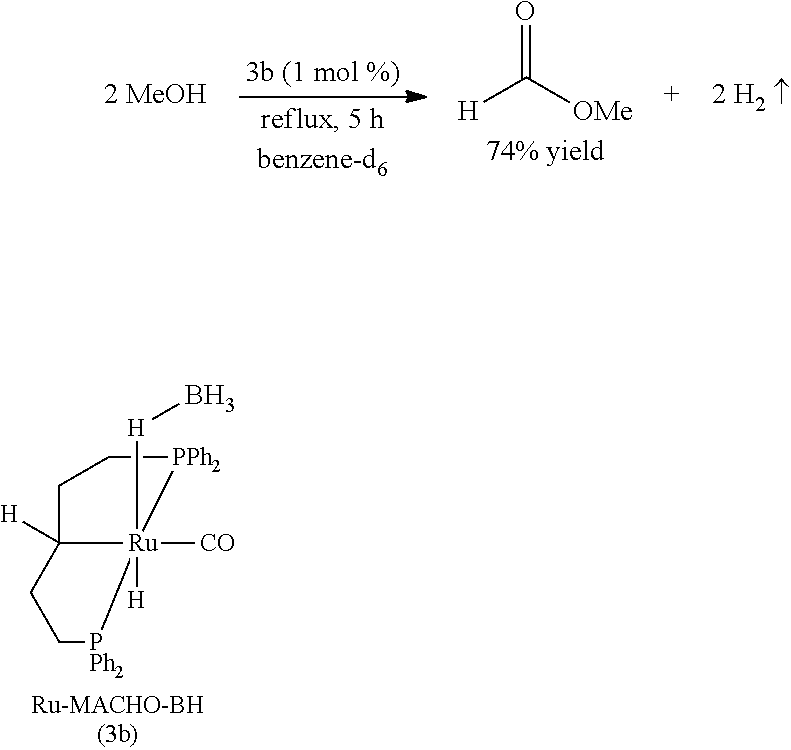
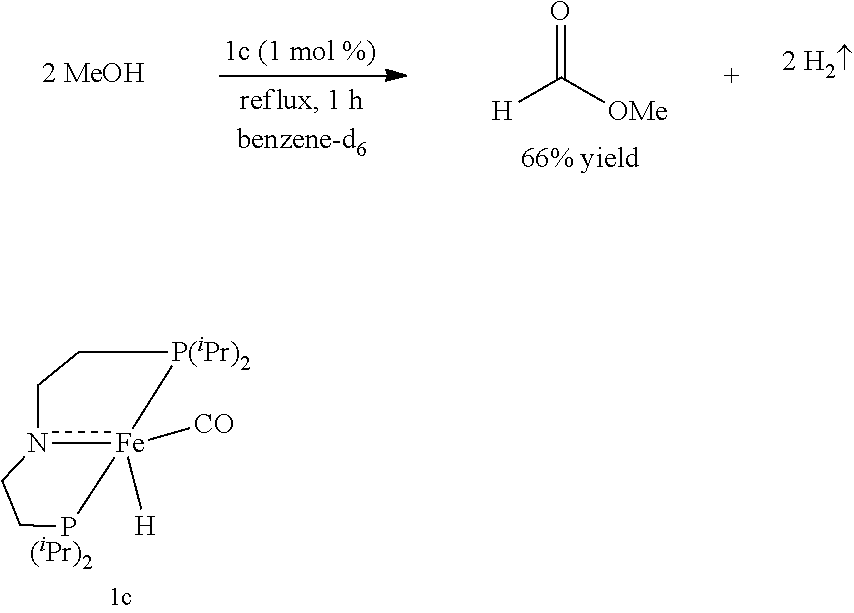
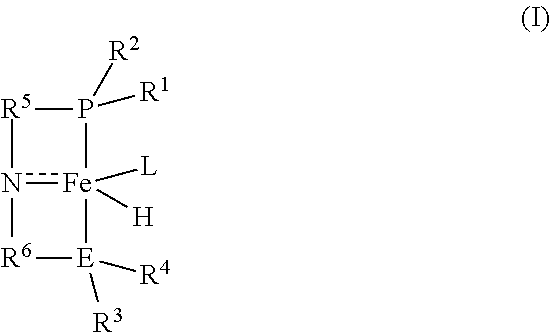
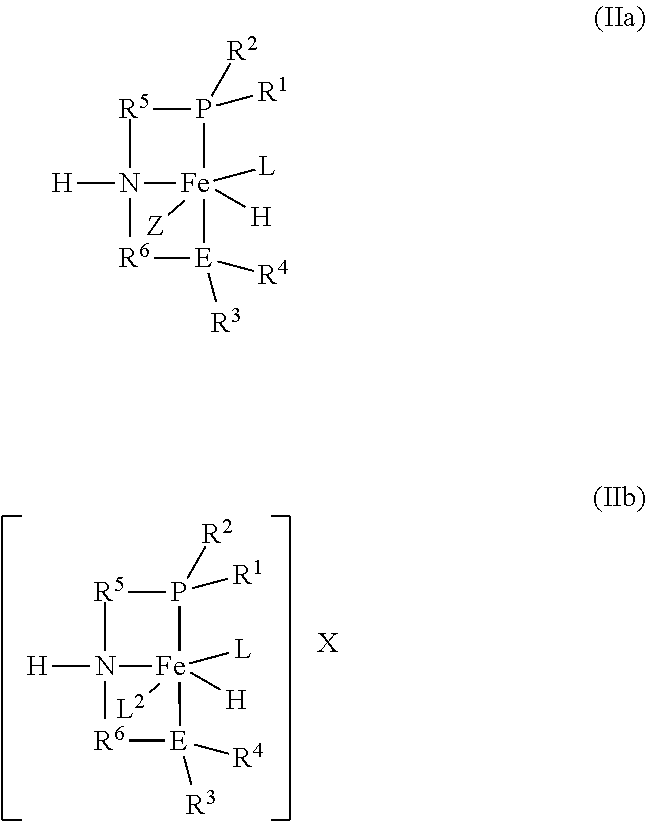
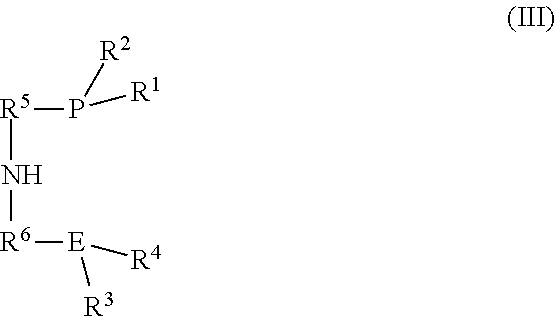

XML
uspto.report is an independent third-party trademark research tool that is not affiliated, endorsed, or sponsored by the United States Patent and Trademark Office (USPTO) or any other governmental organization. The information provided by uspto.report is based on publicly available data at the time of writing and is intended for informational purposes only.
While we strive to provide accurate and up-to-date information, we do not guarantee the accuracy, completeness, reliability, or suitability of the information displayed on this site. The use of this site is at your own risk. Any reliance you place on such information is therefore strictly at your own risk.
All official trademark data, including owner information, should be verified by visiting the official USPTO website at www.uspto.gov. This site is not intended to replace professional legal advice and should not be used as a substitute for consulting with a legal professional who is knowledgeable about trademark law.